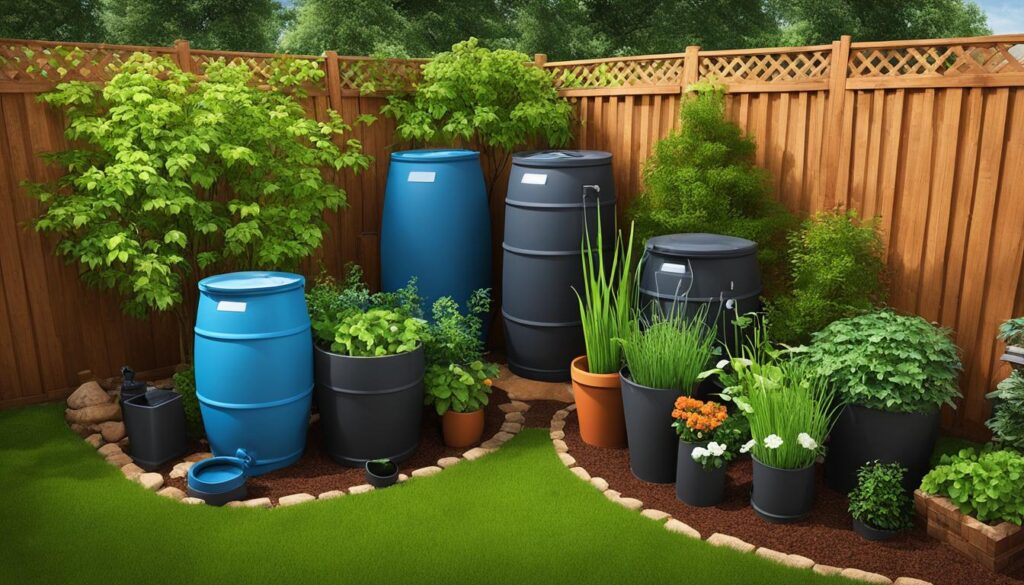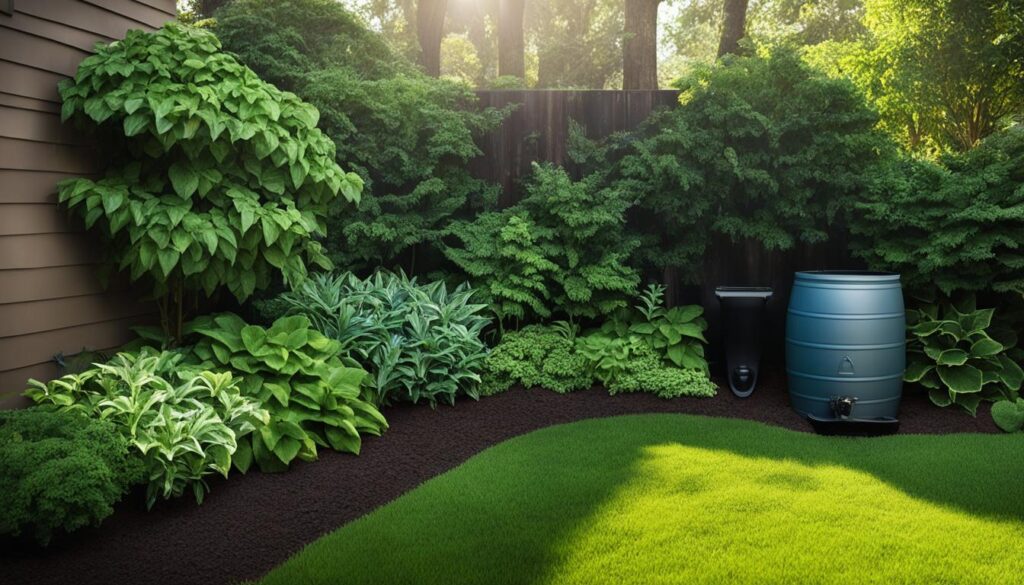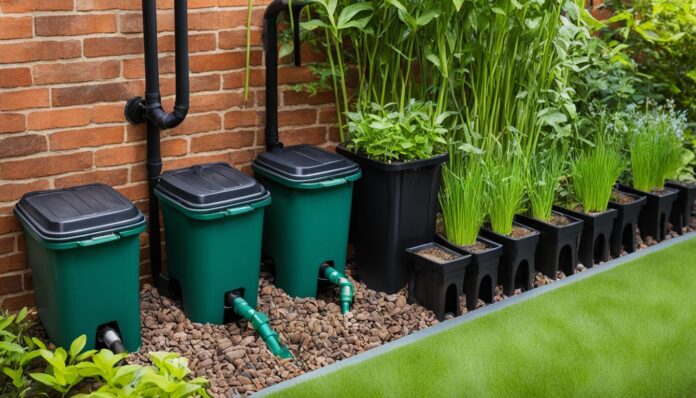Many gardeners are turning to rainwater collection as a way to water their plants while reducing water consumption and promoting sustainability in gardening. Rainwater is a soft and chemical-free source of water that is ideal for plants. By installing water butts, gardeners can easily collect and store rainwater for use in their gardens, saving water and reducing their environmental impact.
Key Takeaways:
- Rainwater collection is a sustainable way to water your garden.
- Collecting rainwater helps reduce water consumption and promotes eco-friendly gardening practices.
- Water butts are easy to install and provide a free source of water for plants.
- Different types of water butts are available to suit your garden’s size and budget.
- Installing water butts is a step towards water conservation and a greener future.
Why collect rainwater?
Collecting rainwater has several benefits. Firstly, it helps to saving water and reduce reliance on hosepipes or garden taps, thereby reducing water bills. Secondly, rainwater is free of harsh chemicals and naturally soft, making it an excellent choice for watering plants. Additionally, collecting rainwater promotes eco-friendly gardening practices and water conservation, contributing to a more sustainable approach to gardening.
How to Collect Rainwater
Collecting rainwater for your garden is an excellent way to save water and promote sustainable garden practices. There are various methods to effectively collect rainwater, ensuring it can be used efficiently in your garden.
Installation of Guttering and Water Butts
One popular method is to install guttering along the roof edges of your house or garden buildings to catch rainwater run-off. This helps to channel the water towards a water butt for storage. A roof downpipe can then be connected to the water butt, allowing the rainwater to flow directly into it.
Alternatively, you can create a more intricate system by using extra guttering or rills to direct the rainwater to different areas of your garden. This allows you to optimize water usage by supplying specific areas such as water features, raised beds, ponds, or rain gardens with rainwater. Consider incorporating water bowls strategically around your garden for easy access to rainwater.
Benefits of Rainwater Collection
“Rainwater harvesting can significantly reduce water consumption, promote sustainable garden practices, and contribute to a healthier environment.”
Implementing a rainwater collection system offers numerous benefits. Not only does it provide a free source of water, but rainwater is also naturally soft and free from harsh chemicals, making it ideal for watering plants.
By utilizing rainwater, you can reduce your reliance on mains water, ultimately saving money on your water bills. Additionally, rainwater harvesting is an eco-friendly practice that helps conserve water resources and plays a crucial role in sustainable garden management.
Rainwater Collection Methods
| Rainwater Collection Method | Description |
|---|---|
| Guttering and Water Butts | Guttering is installed along the roof edges to catch rainwater, which is then directed into a water butt for storage. |
| Extra Guttering and Rills | Additional guttering or rills are used to channel rainwater to specific areas of the garden, such as water features, raised beds, ponds, or rain gardens. |
| Water Bowls | Water bowls are strategically placed around the garden to provide easy access to rainwater for watering plants. |
Table: Rainwater Collection Methods showcasing different techniques to collect and utilize rainwater in the garden.
Types of Water Butts

When it comes to rainwater collection, there are several options to choose from. Different types of water butts cater to different needs, providing flexibility and customization for your garden water management system.
Plastic Water Butts
Plastic water butts are a popular choice due to their lightweight nature and affordable price range. They are easy to install and move around the garden as needed. These water butts come in various sizes, offering options for gardens of all shapes and sizes.
Steel Water Butts
For those seeking durability and longevity, steel water butts are an excellent choice. These robust tanks are built to withstand harsh weather conditions and can last for many years. While they may be more expensive than plastic water butts, their sturdiness makes them a worthwhile investment.
Water Butts with Integrated Planters
For a visually pleasing addition to your garden, consider water butts that come with integrated planters. These stylish options combine functionality with aesthetics, allowing you to grow plants directly on top of the water butt. They add a touch of greenery to your water collection system, enhancing the overall appeal of your garden.
Water Tanks
If you have a large garden or want to store a substantial amount of rainwater, water tanks are ideal. These larger alternatives to water butts offer significantly greater storage capacity, ensuring you have an ample supply of rainwater for your garden’s needs. Water tanks come in various sizes and materials, providing flexibility in terms of both storage capacity and design.
Choose a water butt or tank that suits your garden size, material preference, and budget. Consider the amount of rainfall in your region and the watering requirements of your plants to determine the most suitable option for your garden water management system.
| Water Butt Type | Key Features |
|---|---|
| Plastic | Lightweight, affordable, various sizes |
| Steel | Durable, long-lasting, withstands harsh weather |
| Integrated Planters | Stylish, functional, adds aesthetic appeal |
| Water Tanks | Larger storage capacity, suitable for big gardens |
Water Butt Installation
Installing a water butt in your garden is a simple and effective way to manage water and promote sustainability. With just a few steps, you can start collecting and utilizing rainwater for all your gardening needs.
To begin, follow these easy instructions:
- Identify a suitable downpipe for connection to the water butt.
- Cut the downpipe to the desired length, ensuring it reaches the water butt.
- Attach a rainwater diverter fitting to the downpipe to ensure proper water flow.
- Measure and mark a spot on the water butt for the connector hose.
- Drill a hole at the marked spot to create an opening for the connector hose.
- Attach the connector to the water butt, making sure it fits securely.
- Connect the other end of the hose to the rainwater diverter fitting.
- Ensure that the water butt is firmly attached and positioned to collect rainwater effectively.
By following these steps, you’ll have successfully installed a water butt in your garden, ready to capture valuable rainwater for your plants and promote efficient water management.
Now that your water butt is installed and ready to collect rainwater, you can enjoy the benefits of sustainable garden watering while reducing water consumption.
Benefits of Water Butt Installation

Installing a water butt offers several significant benefits for gardeners and the environment. By collecting and utilizing rainwater, gardeners can enhance their water management practices, promote water conservation, and contribute to a more sustainable approach to gardening.
1. Free Source of Water for Plants
One of the primary benefits of water butt installation is the availability of a free and abundant source of water for plants. By collecting rainwater, gardeners can reduce their reliance on mains water and lower their water bills. This not only benefits the garden but also helps to conserve precious water resources.
2. Contributes to Water Conservation
Utilizing rainwater instead of treated tap water promotes water conservation. Water butt installation enables gardeners to tap into a natural resource and reduce their water consumption. By conserving water, gardeners play a vital role in preserving water sources and ecosystems, contributing to a more sustainable future.
3. pH Balance and Limescale Prevention
Using rainwater in the garden can help maintain the pH balance of the soil. Unlike tap water, rainwater is naturally soft and free of the chemicals found in treated water. Additionally, rainwater does not contain limescale deposits, which can accumulate over time and negatively affect plant health. By utilizing rainwater, gardeners ensure a healthier growing environment for their plants.
Overall, water butt installation is a sustainable and eco-friendly choice for garden watering. It provides a free source of water, promotes water conservation, and helps maintain the health of plants and soil. By incorporating water butt installation into garden water management practices, gardeners can contribute to a greener and more water-conscious future.
Choosing the Right Water Butt
When it comes to garden water management and reducing water consumption, choosing the right water butt is essential. Several factors should be considered, including size, material, and budget. By selecting a water butt that meets your specific needs, you can effectively collect rainwater and contribute to a more sustainable approach to gardening.
Factors to Consider
Consider the following factors when choosing a water butt:
- Size: Evaluate the available space in your garden and choose a size that fits comfortably. If space is limited, opt for a smaller water butt with a lower capacity.
- Material: Plastic water butts are lightweight and cost-effective, while steel water butts offer durability and longevity. Select the material that aligns with your preferences.
- Budget: Determine your budget for purchasing a water butt. Plastic options are generally more affordable, while steel water butts tend to be pricier.
By carefully considering these factors, you can select a water butt that suits your garden’s needs and effectively reduces water consumption.
| Water Butt Type | Advantages |
|---|---|
| Plastic Water Butts | Lightweight and inexpensive option |
| Steel Water Butts | Durable and long-lasting |
Note: The table above provides a comparison of two common types of water butts.
Choosing the Right Water Butt
“The right water butt can be the key to effective garden water management and reducing water consumption.”
Remember to consider your garden’s specific requirements when choosing a water butt. Assess the available space, desired capacity, and material preferences. By making an informed decision, you can optimize your garden’s water usage and contribute to a more sustainable and eco-friendly approach to gardening.
Other Water-Saving Options
In addition to installing water butts, there are several other water-saving options to consider for efficient garden watering and reducing water consumption.
1. Self-Watering Plant Pots
Self-watering plant pots are a great solution for gardeners who want to ensure their plants receive the proper amount of water without wasting any. These pots feature a reservoir that holds water, allowing the plant to draw moisture as needed. This innovative design helps prevent overwatering and reduces water waste.
2. Raised Bed Planters
Raised bed planters are another excellent choice for water-efficient gardening. By creating raised beds, gardeners can control the soil moisture levels more effectively. They can use techniques like mulching and deep watering to promote water retention and reduce the frequency of watering. The result is a more sustainable and water-conscious approach to gardening.
3. Rain Gardens
Rain gardens are specially designed areas in the garden that use rainwater runoff for watering plants. These gardens are strategically positioned to collect rainwater, preventing it from running off into drains or sewers. The collected rainwater is then filtered naturally through the garden’s soil before being absorbed by the plants. Rain gardens not only help save water but also contribute to biodiversity and provide habitat for various beneficial insects and animals.
4. Rainwater Terraces
Rainwater terraces are another innovative option for managing and utilizing rainwater in the garden. These terraces consist of a series of steps or platforms designed to capture and retain rainwater. As the rainwater moves from one level to the next, it is gradually absorbed by the plants, reducing the need for additional watering. Rainwater terraces are not only practical but also add visual interest to the garden landscape.
Consider incorporating these water-saving options in conjunction with water butts to create a comprehensive garden water management system. By implementing a combination of these methods, you can play an active role in reducing water consumption, promoting sustainability, and contributing to a greener future.
| Water-Saving Options | Benefits |
|---|---|
| Self-Watering Plant Pots | – Efficient water usage – Prevents overwatering |
| Raised Bed Planters | – Controlled soil moisture – Reduces watering frequency |
| Rain Gardens | – Utilizes rainwater runoff – Enhances biodiversity |
| Rainwater Terraces | – Manages rainwater efficiently – Adds visual appeal |
Join the water conservation movement
By installing water butts and adopting other water-saving methods, gardeners can contribute to the water conservation movement and promote sustainability in gardening. This not only helps reduce water consumption but also fosters a more environmentally responsible approach to gardening.
Being conscious of water usage is crucial in today’s world, where water scarcity is becoming a pressing issue. Gardeners can take simple yet effective steps towards reducing water consumption. One such step is participating in community workshops and discussions on water conservation. These platforms provide valuable insights and practical tips on how to make a difference in your own garden.
To create a greener and more water-conscious future, embrace the principles of sustainability in gardening. Explore eco-friendly irrigation techniques, such as drip irrigation or using a mulch layer, to further reduce water wastage. Additionally, be mindful of plant selection and group plants with similar water requirements together, ensuring efficient watering practices.
By joining the water conservation movement, gardeners contribute to the larger goal of preserving our precious water resources. Together, we can create thriving gardens while minimizing the impact on the environment. Let’s embrace sustainable practices and make a positive change towards a water-conscious future.
FAQ
Why is it beneficial to install water butts for collecting rainwater in the garden?
Installing water butts allows gardeners to save water, reduce reliance on hosepipes or garden taps, and lower water bills. Rainwater is also free of harsh chemicals and naturally soft, making it an excellent choice for watering plants. Collecting rainwater promotes eco-friendly gardening practices and water conservation, contributing to a more sustainable approach to gardening.
How can I collect rainwater in my garden?
To collect rainwater, homeowners can install guttering along the roof edges of their house or garden buildings to catch rainwater run-off. A roof downpipe can then direct the water into a water butt for storage. Alternatively, the water can be channeled via extra guttering or rills to various areas of the garden, such as water features, raised beds, ponds, or rain gardens. Water bowls can also be installed around the garden for easy access to rainwater.
What types of water butts are available for rainwater collection?
There are various types of water butts available for rainwater collection. Plastic water butts are lightweight and cheaper options, while steel water butts are more durable and long-lasting. Some water butts come with integrated planters or elegant designs, adding aesthetic appeal to the garden. Water tanks are larger alternatives to water butts, storing significantly more water. Choose a water butt that suits your garden size, material preference, and budget.
How do I install a water butt for rainwater collection?
Installing a water butt is a straightforward process. Start by identifying a suitable downpipe for connection to the water butt. Cut the downpipe to the desired length, and attach a rainwater diverter fitting to ensure proper water flow. Measure and mark a spot on the water butt for the connector hose, then drill a hole for installation. Attach the connector to the water butt, and connect it to the rainwater diverter. Ensure the water butt is securely attached and ready to collect rainwater.
What are the benefits of installing water butts in the garden?
Installing a water butt provides a free source of water for plants, reducing reliance on mains water and saving money on water bills. It also promotes water conservation by utilizing rainwater instead of treated tap water. Additionally, using rainwater can help maintain the pH balance of the soil and prevent the buildup of limescale deposits. Overall, water butt installation is a sustainable and eco-friendly choice for garden watering.
How do I choose the right water butt for my garden?
When choosing a water butt, consider factors such as size, material, and budget. If space is limited, opt for a smaller water butt with a lower capacity. Plastic water butts are lightweight and inexpensive, while steel water butts are more durable and long-lasting. Determine the needs of your garden and select a water butt that aligns with those requirements. Remember to consider the available space and the amount of rainwater you expect to collect.
Are there any other water-saving options for garden watering?
Yes, there are other water-saving options for garden watering. Self-watering plant pots and raised bed planters can efficiently use water while reducing waste. Rain gardens and rainwater terraces offer innovative ways to manage and utilize rainwater in the garden. Consider these options in combination with water butts to create a comprehensive water management system that promotes sustainability and reduces water consumption.
How can I contribute to the water conservation movement?
By installing water butts and adopting other water-saving methods, gardeners can contribute to the water conservation movement and promote sustainability in gardening. It is essential to be conscious of water usage and take steps towards reducing water consumption. Participate in community workshops and discussions on water conservation to learn more about how you can make a difference. Together, we can create a greener and more water-conscious future.

